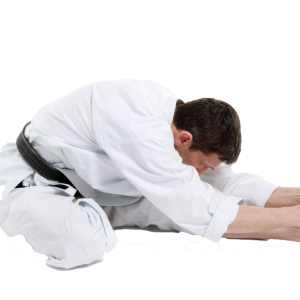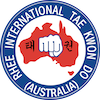Students of Rhee Tae Kwon-Do are encouraged to expand their knowledge of the Art but also keep up to date with changes in health & fitness science. To assist in this, here are some information on stretching plus links to knowledgeable websites. (If any of these links fail, please inform us.
Stretching
 There are 3 basic forms of stretching, dynamic, static active and static passive. ‘Ballistic’ stretching is similar to dynamic stretching but harder to control and is therefore more dangerous. Ballistic stretching is the fast movement of a joint to its extreme limits in an attempt to increase the joint’s range. Ballistic stretching is inappropriate for most activities but as Tae Kwon Do is very ballistic in nature, there is a place for this stretching when done mindfully, well controlled and in preparation for very fast moving techniques.
There are 3 basic forms of stretching, dynamic, static active and static passive. ‘Ballistic’ stretching is similar to dynamic stretching but harder to control and is therefore more dangerous. Ballistic stretching is the fast movement of a joint to its extreme limits in an attempt to increase the joint’s range. Ballistic stretching is inappropriate for most activities but as Tae Kwon Do is very ballistic in nature, there is a place for this stretching when done mindfully, well controlled and in preparation for very fast moving techniques.
The purpose of stretching is to increase the range of motion (ROM) of a joint but this should always be done in the safest manner to protect the long term viability of the joint and its surrounding structure. There are 3 limitations to a joint’s ROM, the length of associated muscle and tendons, the length and flexibility of the interconnecting ligaments across a joint and the nervous system.
Often too much emphasis is given to stretching the muscles and not enough given to the other aspects of flexibility. Choosing the right types of stretching for your particular activity is very important and easily demonstrated with a jump test. Immediately after warming up the muscles, stand beside a wall and jump as high as possible. Now sit down and do some static stretching for about 10 minutes. Your flexibility will be increased (probably slightly) and repeat the jump test. Did you jump higher? Now do 5 minutes of dynamic stretching and repeat the jump test. Most likely you will have jumped the highest of these attempts. Why? Jumping is a dynamic activity, it requires movement and quite fast movement at that. Whereas static stretching can improve the ROM of your joints, it does not prepare the muscles or particularly the nervous system for dynamic movement. Always do dynamic stretching before doing a dynamic activity, such as Tae Kwon Do and thus maintain your health & fitness.
Many health and fitness activities will concentrate on static stretching. Static passive stretching is where there is no, or very little movement. Examples include bringing your arm across your chest using the other arm in order to stretch the shoulder joint. Another is sitting on the floor and reaching forward to touch your toes in order to stretch your leg’s hamstring muscles. These are static because there is no movement and there definitely should be no bouncing as this is counter productive and dangerous like ballistic stretching. This type of stretching is beneficial to all sports.
Static active stretching is where there is also no movement but you use one muscle group to activate a stretch in its opposing (antagonistic) muscle group. For example the hamstrings must relax in order for you to use your quads to raise your leg forwards. This also has the benefits of strengthening the quads. This type of stretching is of most benefit to athletes who need to hold a position, such as dancers or figure skaters. Advanced variations of static stretching include Proprioceptive Neuromuscular Facilitation (PNF) and Contract-Relax-Antagonist-Contract (CRAC) stretching.
Dynamic stretching involves movement, repeatedly taking the joint through its current ROM and slightly beyond. But this must be done with care and some reference so that the ROM is increased slowly. One of the limitations of ROM is caused by the nervous system protecting a joint. The nervous system will engage a contraction response (the opposite of what is desired) in a muscle if it thinks that the joint may be damaged a long time before actual damage to the joint is likely. Thus by slowly increasing the ROM through dynamic movement, we are re-programming the nervous system to accept a greater ROM, along with actual stretching of the muscle fibres. Static stretching does not perform this re-programming of the nervous system in preparation for dynamic movements such as found in Tae Kwon Do.
Thus, individuals should be encouraged to do static stretching as often as possible, well before class. Class warm should not include static stretching as class time is better spent preparing the muscles for the dynamic activity of TKD by doing very controlled dynamic stretching. Cool down should involve static stretching, even PNF and CRAC stretching for the best long term benefit.
A number of scientific studies have shown that a bi-product of static stretching is a temporary lowering of muscle strength, power output and muscle activation, all counter productive and with a higher risk of injury, in the preparation of the body for the dynamic activities of Rhee Tae Kwon Do. Consider this point when reading articles about health & fitness.

Sports Nutrition –
Good nutrition is important for a healthy body in which to contain your healthy mind.
Free Course – Body Matters: Body101x
Interested in learning more about your body and how exercise helps?
Register for this free course on EdX: Body Matters – Body101x
Exercise is promoted as a fundamental component of a healthy lifestyle. Ever wonder why? Exercise is more than just an “art of converting big meals and fattening snacks into back strains and pulled muscles by lifting heavy things that don’t need to be moved, or running when no one is chasing you.” (Anonymous quote).
Did you know that physically active obese individuals live longer than inactive thin individuals? Are you interested in seeing the evidence on the benefits and risks of stretching? What is the best way to treat your ankle, knee, and/or shoulder injury? How does injury affect mood and what are the consequences?
Presented by: McGill University

Concussion
Although being a non-contact martial art for the most part, accidents may still happen resulting in a concussion. The Pocket Concussion Recognition Tool from the British Journal of Sports Medicine can be used to recognise an instance of concussion. Remember though to always err on the side of caution.
The PocketCRT can be downloaded from here:
http://bjsm.bmj.com/content/bjsports/47/5/267.full.pdf


Anatomy
Websites that will give you insights into your body. Some understanding of how your body is constructed and how it works will help to improve your health & fitness training and prevent injury.

